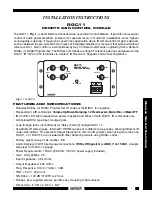
BASIC commands
PROGRAMMING MANUAL
198
R
e
vi
si
o
n
1
.0
3.2.298 TSIZE
/i
3.2.299 UNITS
/i
3.2.300 UNLOCK
See
LOCK
.
3.2.301 UNTIL
See
REPEAT..UNTIL
.
3.2.302 VECTOR_BUFFERED
/i
Description
The
TRUE
constant returns the numerical value -1.
Arguments
N/A
Example
test:
t = IN(0) AND IN(2)
IF t = TRUE THEN
PRINT "Inputs are ON"
ENDIF
See also
N/A
Type
System parameter (read-only)
Syntax
TSIZE
Description
The
TSIZE
parameter returns the size of the TABLE array, which is one more
than the currently highest defined TABLE element.
TSIZE
is reset to 0 when the TABLE array is deleted using
DEL "TABLE"
or
NEW "TABLE"
on the command line.
Arguments
N/A
Example
The following example assumes that no location higher than 1000 has been
written to the TABLE array.
>> TABLE(1000,3400)
>> PRINT TSIZE
1001.0000
See also
DEL
,
NEW
,
TABLE
.
Type
Axis parameter
Syntax
UNITS
Description
The
UNITS
parameter contains the unit conversion factor. The unit conversion
factor enables the user to define a more convenient user unit like m, mm or
motor revolutions by specifying the amount of encoder edges to include in a
user unit.
Axis parameters like speed, acceleration, deceleration and the Axis com-
mands are specified in these user units.
Note: The
UNITS
parameter can be any non-zero value, but it is recom-
mended to design systems with an integer number of encoder pulses per user
unit. Changing
UNITS
will affect all axis parameters which are dependent on
UNITS
in order to keep the same dynamics for the system.
Note: The Gear ratio inside the MECHATROLINK servodrives affects the res-
olution of the motor encoder.
Arguments
N/A
Example
A leads crew arrangement has a 5mm pitch and a 1,000-pulse/rev encoder.
The units must be set to allow moves to be specified in mm.
The 1,000 pulses/rev will generate 1,000 x 4 = 4,000 edges/rev. One rev is
equal to 5mm. Therefore, there are 4,000/5 = 800 edges/mm.
UNITS
is thus
set as following.
>> UNITS = 1000*4/5
See also
AXIS
,
ENCODER_RATIO
.
Type
Axis parameter (read only)
Syntax
VECTOR_BUFFERED
Description
This holds the total vector length of the buffered moves. It is effectively the
amount the system can assume is available for deceleration.
















































